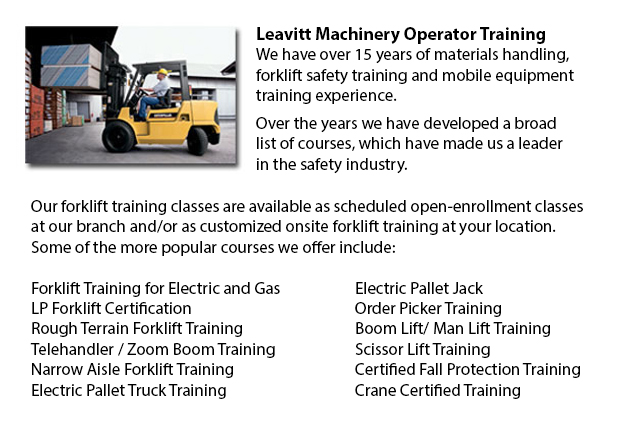
Forklift Training Schools Langley - What Could Individuals Learn From Our Forklift Training Schools
Are you searching for work as a forklift driver? Our regulatory-compliant mobile equipment operator training provides instruction in kinds of lift trucks, pre-shift check, fuel types and dealing with fuels, and safe operation of a lift truck. Practical, hands-on training assists individuals participating in obtaining basic operational skills. Program content consists of current regulations governing the operation of forklifts. Our proven forklift courses are intended to provide training on these kinds of trucks: counterbalanced forklift, powered pallet trucks and narrow isle forklift.
When the lift truck is in use, do not raise or lower the forks. Loads must not extend above the backrest. This is because of the danger of the load sliding back towards the operator. Check for overhead obstructions and ensure there is adequate clearance before lifting a load. Stay away from overhead power lines. Once the load is lifted straight up, tilt it back slightly.
While the load is lifted the lift truck will be less steady. Make sure that no pedestrians cross under the elevated fork. The operator should not leave the lift truck while the load is raised.
When handling pallets, forks must be high and level enough to go into the pallet and extend all the way beneath the load. The fork's width must provide equal distribution of weight.
Before loading or unloading the truck, chock the wheels and set the brakes. Floors should be strong enough to support the weight of the forklift and the load combined. Fixed jacks could be installed in order to support a semi-trailer which is not coupled to a tractor. The entrance door height must clear the forklift height by a minimum of 5 cm. Edges of docks, rail cars and ramps should be marked and avoid them.
-
Boom Lift Certification Langley
Boom Lift Certification Langley - Making use of elevated work platforms allow for maintenance operations and work to be performed at elevated work heights which were otherwise unreachable. Boom Lift Certification Training educates workers about safel... More -
Boom Lift Training Langley
Boom Lift Training Langley - Elevated work platforms, likewise referred to as aerial platforms, enable workers to carry out tasks at heights which would otherwise be unreachable. There are various types of lifts intended for various site applications... More -
Wheel and Track Loader Training in Langley
Lift trucks are available in a variety of various units that have varying load capacities. The majority of typical lift trucks used in warehouse settings have load capacities of 1-5 tons. Larger scale models are used for heavier loads, like loading s... More -
Counterbalance Forklift License Langley
Counterbalance Forklift License Langley - When operated by completely trained operators, forklifts could become a major advantage for firms and companies. We can offer your employees a thorough training program which consists of all factors of operat... More -
Aerial Lift Ticket Langley
Aerial Lift Ticket Langley - A boom truck is frequently recognized by the cable and telephone company vans that have the elongated arm folded over their roofs. Commonly, a bucket-like apparatus sits at the extension of extendable arms. Often termed a... More -
Aerial Lift Training Langley
Aerial Lift Training Langley - An aerial work platform is a mechanized access platform. This particular device provides access to otherwise not accessible places for equipment or people. Likewise known as an aerial device or elevating work platform,... More -
Wheel Loader Operator Training Langley
Wheel Loader Operator Training Langley - To be able to raise considerable weights, industrial cranes utilize pulleys and levers. In the past, Romans utilized cranes to construct huge monuments making the origin of these equipment at least two thousan... More -
Manlift Safety Training Langley
Manlift Safety Training Langley - It is important for competent Manlift operators to be aware of the connected dangers which come with particular kinds of scissor lifts. They must be able to operate the scissor lift in a way that protects not just th... More

Forklift Training Langley
TOLL FREE: 1-888-254-6157
Langley, British Columbia
forklifttraininglangley.com
Email Us
About Us


